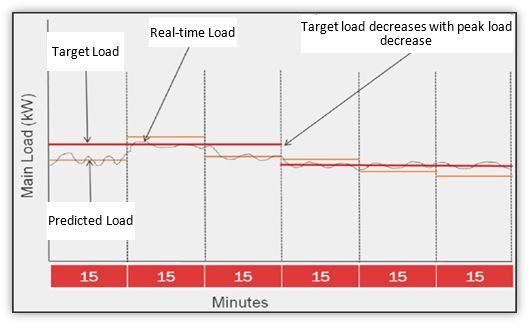Introduction to Real-Time Load Management
Demand is essentially the “need for electricity” and its peak value influences energy cost and grid stability. Utilities measure and track demand to determine how much electricity each customer will potentially need and how much electricity should be generated to fulfill that need. It’s a balancing act. These demand peaks can be managed in real-time through modern technology and supplement initiatives such as demand response by automatically mitigating excessive energy demand. For instance, GridPoint’s smart building platform incorporates a patented load curtailment algorithm to provide increased versatility to customers by avoiding new demand peaks, providing a flexible load, and meeting DR criteria. GridPoint’s platform enables users to collect actionable energy information and facility insights across millions of data points. Running algorithms, such as load curtailment, helps conserve energy and make smart use of building assets.
How Does Avoiding New Demand Peaks Save Money?
Utilities offer incentive programs aimed at decreasing demand to improve grid reliability. The benefits of managing electricity demand can also be shared by the customer through rebates and reduced equipment burden. Customers of any size or vertical will likely notice a “demand charge” on their electricity bill. This charge is based on a customer’s demand (also known as peak kW) during a given billing cycle. Keeping total building demand low helps drive savings and ensures that your energy management goals are met.
Load Curtailment: GridPoint’s Demand-Reducing Strategy
GridPoint’s Advanced Control Algorithm, Load Curtailment, can be utilized independently of or in conjunction with initiatives such as demand response. This intelligent energy management strategy can be leveraged by any GridPoint-controlled site with main load metering. The algorithm can be deployed remotely by GridPoint and requires no action from the end user to keep them saving year-round.
How Does it Work?
Load Curtailment (LC) works by limiting the energy use of controlled assets, such as HVAC units. The algorithm utilizes machine learning to understand each building individually and anticipate when it will hit peak load. When a threshold is crossed, the algorithm automatically curtails the building’s load to keep demand in check while balancing comfort. When the load is decreased past another threshold building operations return to normal. This differs from traditional utility-sponsored demand response programs because it’s continuous and designed for customer savings whereas DR events are only called on during times when the grid is stressed.
Benefits of Load Curtailment
This algorithm helps reduce your monthly demand charge by shifting, shaping, and shedding load intelligently, mitigating the impact to comfort. The parameters of the algorithm are customizable, providing end users the flexibility to fine-tune their curtailment program based on specific goals. There are currently over 15,000 sites installed with GridPoint’s platform, thousands of which are enrolled in load curtailment. Target demand activity and algorithm runtime channels are accessible in GridPoint Energy Manager, giving you deeper insight into the algorithm’s performance and its influence on on-site operation. Technology like GridPoint’s load curtailment algorithm is a low-risk, high-reward solution for dynamically reducing demand and enhancing your business’ electricity savings.
